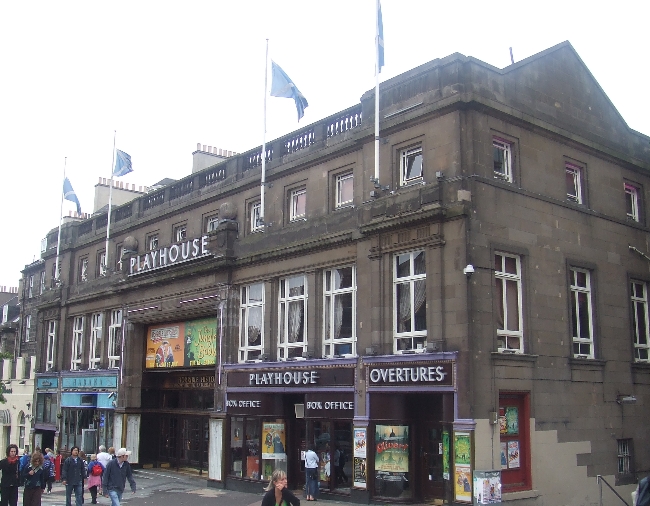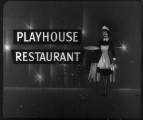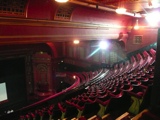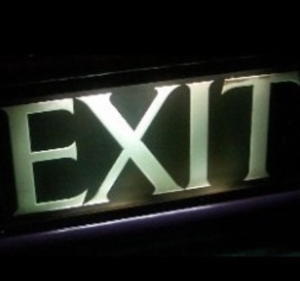Scottish Cinemas and Theatres
Back Main
Playhouse
18 - 22 Greenside Place

 |  |
[Many thanks to Larry McGuire for detailed information about the building's history]
 | A gallery of interior photos from September 2008 can be seen here. |
John Fairweather was born in Glasgow in 1867 and died 1942. He specialised in designing cinemas for travelling families who were showing film performances at fairgrounds but wanted to settle down with permanent venues. Most of his cinemas were built for the Kemp and Green families and he principally worked for George Green from 1913 onwards. He is probably best known for creating the largest cinema in Europe, Green’s Playhouse in Glasgow, which seated 4368 people. Prior to this, Fairweather was sent to the US by the Green family from 1922-23 in order to study cinema design there, and was particularly interested in the buildings by Thomas Lamb (a Scottish emigrant).
Opening on the ‘Glorious Twelfth’ of August, 1929, the Playhouse originally seated 3,040. These were made up of 1,500 seats in the Stalls (coloured crimson, costing 1/3), 680 in the circle (coloured purple, costing 2/4), and 860 in the balcony (coloured old gold, costing 1/- in the front, 9d in the back). Despite its huge stage, and numerous dressing rooms (stage 45ft deep, 85 ft wide; 30 dressing rooms; proscenium 49ft wide by 38ft high.), the Playhouse was designed and built to be first and foremost a cinema, by one of Scotland’s premier cinema architects. The opening notices in the press refer to the 'New Super Cinema - Edinburgh Playhouse' and 'Edinburgh's largest cinema - the Playhouse in Leith Walk.' [3]. Fairweather had studied cinema design in the USA, and brought many ideas back with him to Scotland. The 1927 Roxy was the ‘Cathedral of the Motion Picture’; the largest, grandest and most expensive cinema ever built. The Scotsman suggested that 'The Playhouse has been modelled on the Roxy Cinema Theatre in New York' [3], although this seems likely to refer to its scale and opulence, rather than any direct architectural connection. Edinburgh’s Playhouse is therefore its closest surviving spiritual descendent in Scotland. The gradient on the sloping site is 1 in 4.5; the auditorium was cleverly planned to suit the ground levels. The entrance had shops on either side, and was 'flanked at the corners by a separate entrance to the cafe on two upper floors, and an independent exit from the stalls floor.' [1] There were tea rooms on two floors, plus a tea, coffee and soda fountain lounge [2]. There are several interesting light fittings in the vestibule area, especially the two bronze lamps on either side of main staircase: figures holding lamps, standing on fish with open mouths. There are two deco style ceiling light fittings on either side of the central back-lit glazed ceiling. From here there are steps down in the centre to the stalls and downstairs bars; stairs up on either side of this to the balcony. Entrances straight ahead on either side of these central stairs lead to the circle. The auditorium is 100ft wide by 114 deep; the main ceiling is 66ft high. The interior is not as originally conceived. Early drawings show an atmospheric interior, with Moorish temples in the alcoves either side. As built, it is actually a nautical theme. The rear wall of the original Stalls Foyer and Mezzanine (opposite the stairs going down) was meant to represent an old Galleon, with the columns etc complementing the 'stern of the ship' you were looking towards. All of the bespoke plasterwork throughout the building, is of sea anemonies, conches, and other sea plants. The details around the proscenium arch feature a clam shell with a sea horse on either side, anemone in the centre, and small flowers in the centre of every 'trellis' crossing. The decoration at the bottom of the pilasters either side is a pair of dolphins. The clam shell motif is repeated elsewhere. On each side of the auditorium, at balcony level, there are four panels which have red curtain material behind them. These conceal windows which: 'At suitable times during the day the auditorium can be flushed with nature's cleansers by simply opening the windows in side and end walls, which during the performance are shuttered to exclude the light.' [1]. The panels in the balcony, either side of the windows, with the 'celestial instruments' seem slightly out of place in the general decorative scheme, perhaps 'off the shelf' panels were used at a time when money was beginning to get extremely tight during the final stages of completing the building.
The opening descriptions note that a ‘Brenograph have been fitted up by J Frank Brockliss Ltd’ [1]. Brenographs were designed to project ‘a canopy of clouds moving across a field of twinkling stars as used in the atmospheric theatre to complete the illusion that the pictures are being viewed beneath nocturnal skies’ [9]. They were expensive pieces of equipment; this is the only known documented instance of a Scottish installation. The Brenograph, which was a complete dual unit, with a massive range of rotating effects and attachments, was used to project onto the stage curtains and proscenium area, but only as high up as the bottom of the permanent house border. It was located in the centre of the projection room, and a major limiting factor for the picture size in the Playhouse, was the fact that anything projected from the room 'scraped' the underside of the balcony to get out, and it was only possible to get to around 26' up from the stage floor. The projection booth was situated between the circle and the balcony, reached by a separate entrance from outside. Originally, there were four Simplex projectors, with two fitted out for sound equipment. [2] The throw for the projectors to the screen was 104 ft. Originally there was a cinema organ; this was a three manual, 86-stop Hilsden Organ [2]. At opening, the 'orchestra and organ [...] have unfamiliar habits. The orchestra - when it is not required - disappears quietly by means of an electric lift, and the organ goes up and down by the same unusual means.' [3]. The Organ was built in 1927/28 by Henry Hilsdon of Glasgow, and was the second largest organ ever installed in a Scottish Cinema, and the largest to survive past the mid 1930's. Sections of it were actually built in the basement of the theatre, in a room adjacent to the air handling plant (Plenum Plant) and known until 1986 as 'the organ room'. It had a total of 72 stop tabs controlling stops, tonal percussions, traps (atonal percussions), couplers, and tremulants.
In 1992, the original canopy above the entrance was removed, and at the same time the stage areas were extended and a new area was constructed to improve access to the backstage areas. Even today, it is impressive walking through the building to see how much of the original fixtures and fittings still exist today. In particular, the main doors are wood and glass, with brass fittings. There are numerous light fittings with metalwork and opaque glass shells or scallop shapes, both on the main staircase down to stalls, and in auditorium under the upper balcony. The quality of the finishings is noticeable compared to other cinemas of the period, showing the high budget that had been spent to create the largest, most luxurious cinema for Scotland’s capital city. The upstairs cross-corridor leading to the balcony has several alcoves with large stone urns in them (containing flowers). In the stalls there are several nice large etched-glass lit signage: 'No Smoking', 'Gentlemen' etc. Seats: some have been replaced; most (certainly in the balcony) could be original; with cast iron stanchions between them; and decorative swirls at the end of rows. The Orchestra pit extends under stage (as in the Theatre Royal Glasgow). There are excellent sightlines, even from very rear of the balcony.
General Cinema Context: Top 15 UK Cinemas by Original Seating Capacity
[Source: Picture House #16, 1990/1991, Cinema Theatre Association] As of the Edinburgh Playhouse opening in August 1929, it was the 2nd largest in Scotland, and the 4th largest in the UK. As of 2007, amongst cinema buildings remaining today with intact auditoria, it is the 7th largest in the UK:
References 1. Cinema Construction, August 1929, p 11 - 12 2. Kine Weekly, August 1929 3. Scotsman - 10 August 1929 (description) 4. Scotsman - 12 August 1929 (opening advert) 5. Edinburgh Theatres, Cinemas and Circuses, George Baird, p.399-403 6. The Last Picture Shows: Edinburgh, B Thomas, p.50 7. Buildings of Scotland: Edinburgh, p.439 8. Theatres Trust Guide to British Theatres, p. 62 9. The Best Remaining Seats, BM Hall, 1961, p. 94 10. Cathedrals of the Movies, David Atwell, p.115 11. Cinemas in Britain, Richard Gray, p. 56-7 Scottish Screen Archive Photographs: 6/1/496 (Exterior, 1971) RCAHMS Coverage: here |
Unless otherwise
specified, all photographs and other material copyright (c) 2001
- 2020 Gordon Barr and Gary Painter.
All rights reserved. Permission for use elsewhere normally granted, but please ask first!
No attempt is made to infringe any existing copyrights or trademarks. Please contact the editors in case of any queries.
All rights reserved. Permission for use elsewhere normally granted, but please ask first!
No attempt is made to infringe any existing copyrights or trademarks. Please contact the editors in case of any queries.














